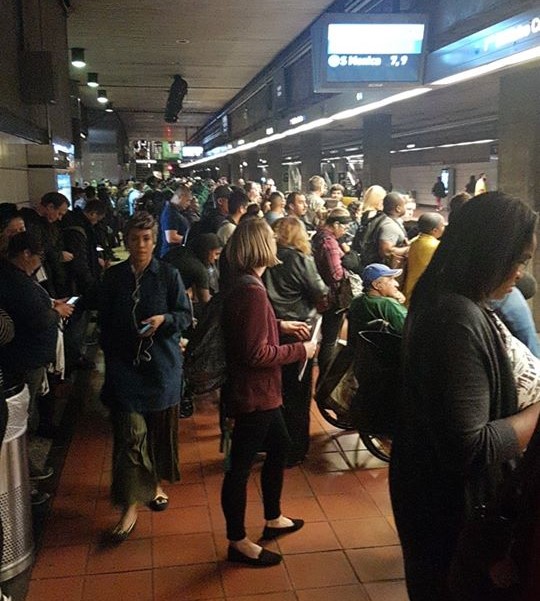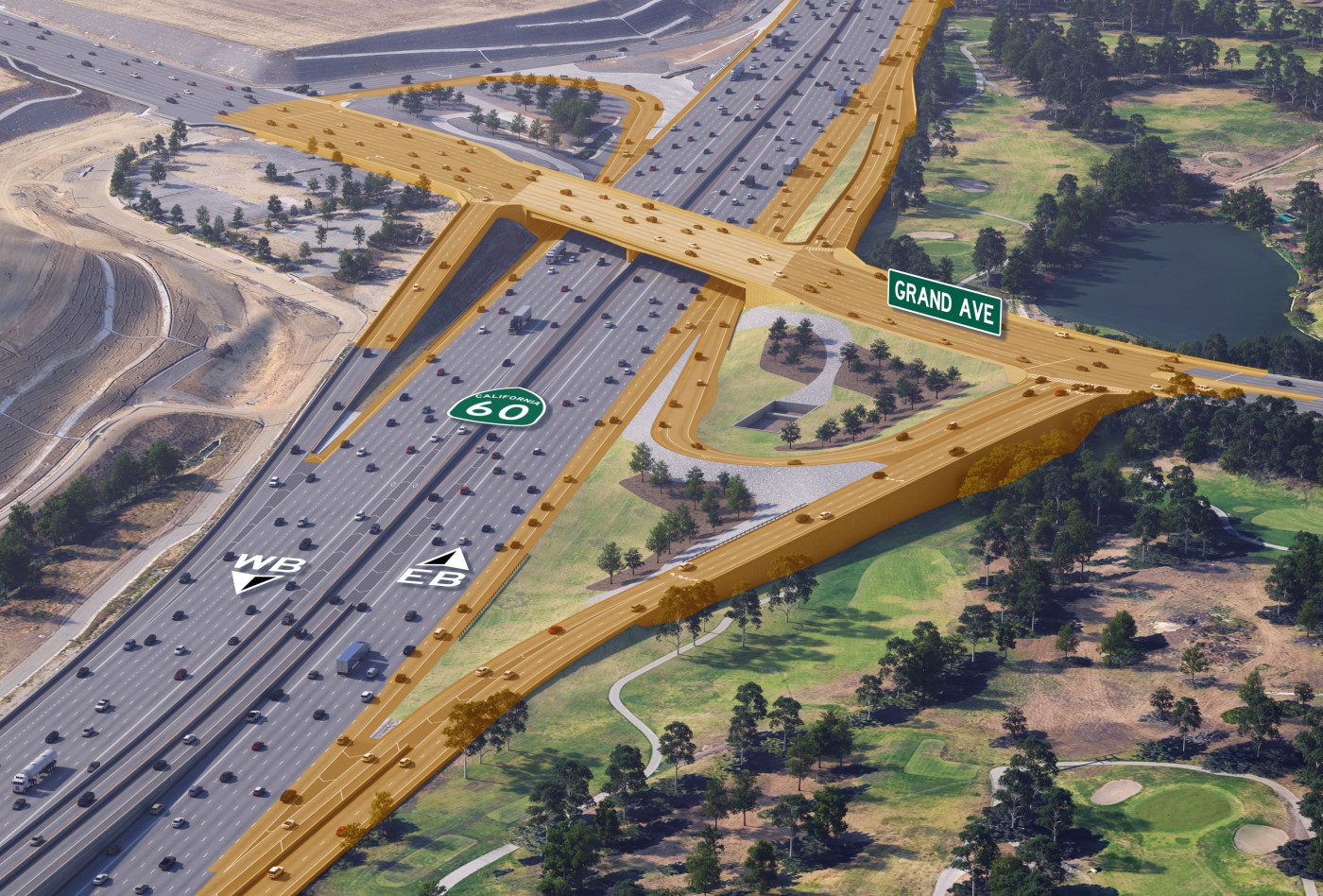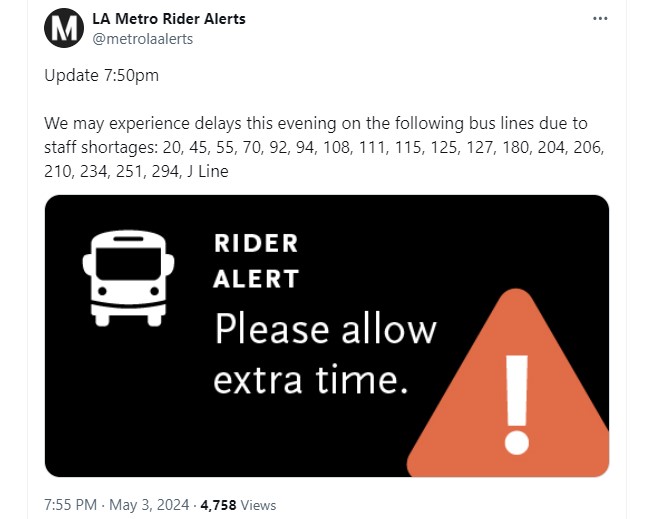Refurbished A Line Off to Rough Start, Delays All Too Common
12:56 PM PST on November 20, 2019

Monday’s Evening rush hour crowds at 7th Street Station. Metro A and E Lines suffered major delays due to power issues. Photo by Rafael Vega
It has been a rough couple of weeks for the newly opened Metro A Line. The former Blue Line is supposed to have been faster and more reliable, but operations have instead been plagued by numerous breakdowns and delays.
On November 2, Metro re-opened the refurbished Blue Line, renaming it the A Line. Portions of the line had been closed since late January for the $350 million "New Blue" refurbishment project. New Blue's completion was delayed more than a month from the initially announced "late September" anticipated completion.
The New Blue improvements are difficult to see. There are new switches, new signal systems, refurbished overhead wires, some new rails, and upgrades to the power system, but the new A Line looks pretty much the same as the old Blue Line. What riders should experience is improved travel times and better reliability.
Since at least 2013, the Blue Line timetable showed a 58-minute end-to-end trip. In 2017, Metro CEO Phil Washington pledged to reduce downtown L.A. to downtown Long Beach trip travel time by 10 minutes. Last month, Washington announced that A Line end-to-end trips would be just seven minutes faster - 51 minutes. The A Line schedule shows a 53-minute trip, only a five-minute improvement. It is anecdotal, but earlier this week SBLA timed trips taking 58 and 54 minutes. Metro has improved travel times somewhat, but has been unable to make these improvements consistent.
The trains are not much faster, but what about reliability?
Not good. At least not yet.
The Long Beach Post reported that "rider after rider is expressing frustration, anger, and stress" over A Line performance.
Metro CEO Phil Washington responded to concerns authoring a LB Post editorial where he acknowledged "some startup hiccups" that Metro is "working aggressively to resolve." Washington asserted that the situation is getting better, citing that "Service has improved over the last few days."
But then on Monday, hundreds of evening rush hour A and E Line riders were temporarily stranded in downtown L.A. due to a "power issue at 7th/Metro."
Getting a bit crowded at 7th/Metro Center.
— Nathan Pope (@npope32) November 19, 2019
Blue/A and Expo/E boarding at of the same platform. pic.twitter.com/4bSl5MdHdY
And that was just the biggest of four A Line outages that occurred on Monday.
In just 19 days of operation, the A Line has experienced 24 significant outages (per Metro's rider alerts):
- Monday 11/18 - DTLA 7th Street power issue
- Monday 11/18 - DTLA 7th Street train with mechanical issue
- Monday 11/18 - Grand/LATTC train with mechanical issue
- Monday 11/18 - vehicle blocking tracks between San Pedro and Washington
- Sunday 11/17 - Grand/LATTC train with mechanical issue
- Sunday 11/17 - planned maintenance DTLA
- Tuesday 11/12 - car crash at Willow (see also Long Beach Post)
- Tuesday 11/12 - train congestion near Del Amo
- Sunday 11/10 - Vernon train with mechanical issue
- Saturday 11/9 - signal issues
- Friday 11/8 - Compton train with mechanical issue
- Friday 11/8 - Washington mechanical issue
- Friday 11/8 - inspection of power supply system
- Thursday 11/7 - Compton signal issue
- Thursday 11/7 - train with mechanical issues
- Thursday 11/7 - Del Amo signal issue
- Wednesday 11/6 - DTLA 7th Street signal issue
- Wednesday 11/6 - reduced speed in Long Beach
- Tuesday 11/5 - trespasser on tracks near Pico
- Tuesday 11/5 - power supply maintenance between Washington and Compton
- Tuesday 11/5 - DTLA 7th Street signal issue
- Monday 11/4 - DTLA signal issue (unclear if this was same as DTLA switch issue)
- Sunday 11/3 - signal issue
- Saturday 11/2 - Grand/LATTC signal issue
So far alert-free days are less common than alert days. Many days see multiple alerts. Many downtown L.A. issues impact E (former Expo) Line riders who share the same tracks.
These outages are attributable to various causes.
In the Post editorial, Washington seemed to shift the blame to factors outside the agency's control:
...riders should recognize that there are a lot of factors that can affect our train schedules, including competing car traffic, accidents, emergencies and police activities. We are working through them.
In regard to travel times, we are working with the cities of Los Angeles and Long Beach to prioritize train service through intersections which, when completed, should yield additional travel time benefits.
In an email to SBLA, Metro spokesperson Brian Haas similarly asserted that:
The majority of service alerts and disruptions since have largely been unrelated to the operation of the A Line, such as a non-Metro-related vehicle crash Monday morning that shut down part of the A Line for more than three hours while it was being cleaned up. Those types of service disruptions are unfortunate, but out of Metro's control.
The alerts listed above appear to tell a somewhat different story.
Many outages stem from the systems that New Blue refurbished: signals and power supply. Very few of these (two cars and one trespasser - in italics above) are clearly attributable to "competing car traffic, accidents, emergencies, and police activities."
Washington wrote that, "A sober assessment of our relaunch reveals that 99 percent of our intensive renovation work was successful" and that "It’s like learning a new dance as Metro train operators and controllers adjust to the different service plan."
But it certainly appears that the A Line reopening was rushed. The new systems were not quite ready.
Today, A Line riders are frustrated and disappointed. They endured an aging line, then closures, and now these operations issues. Imagine that newly opened road or freeway experienced so many "hiccups." Drivers would not tolerate it. Recently, Westside drivers threatened to recall L.A. City Councilmember Mike Bonin over a few minutes delay. But so-called "captive" transit riders are expected to put up with "new dance" delays.
In the near term, the state of good repair should mean a more reliable A Line. Hopefully Metro will make this consistency happen very soon - before too many riders jump ship. Once Metro gets past the hiccups, new power supply and signal systems will be more reliable than the 30-year-old ones they replaced.
In the long run, Phil Washington still needs to make good on his pledge to save A Line riders more time. Metro needs to work diligently with cities to continue to prioritize trains to improve travel times. This is predominantly in downtown Los Angeles, where A and E Lines share tracks. Work is already underway to maximize E Line signal prioritization. Frequent trains there - carrying hundreds of riders - still get delayed due to L.A. City catering to single-occupant vehicles. L.A.'s climate mayor Eric Garcetti needs to think bigger and not be too timid to restrict car traffic to improve A and E Line service.
For decades the Blue Line has been at the heart of Metro's - and even the region's - transportation systems. The line posted Metro's highest ridership numbers while serving many disenfranchised neighborhoods. The A Line needs to up its game if it is to reliably function at the core of a world class transit network.
Stay in touch
Sign up for our free newsletter
More from Streetsblog Los Angeles
This Week In Livable Streets
Bike Month continues, Metro 91 Freeway widening, Destination Crenshaw, Culver City Bus, Santa Monica MANGo, Metro bike lockers, Metro Sepulveda Transit, and more
San Fernando Valley Bus/Bike Updates: G Line, Roscoe Bus Lanes, Laurel Canyon Bike Lanes
Short newly protected bike lane on Laurel Canyon Blvd, extensive NSFV bus improvements under construction this month, and scaled-back G Line plans should get that project under construction this summer
No, L.A. City Does Not Always Add Required ADA Ramps During Resurfacing, But They Should
StreetsLA GM Keith Mozee "Any time we do street resurfacing, it is considered an alteration, which requires ADA ramps to be installed."




